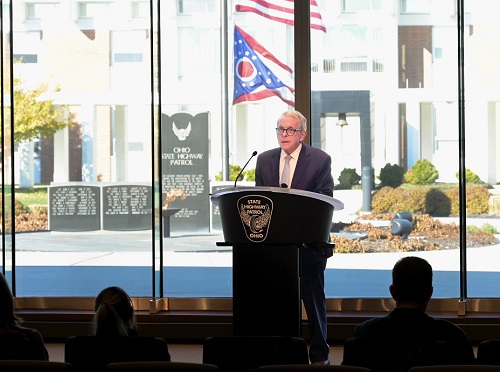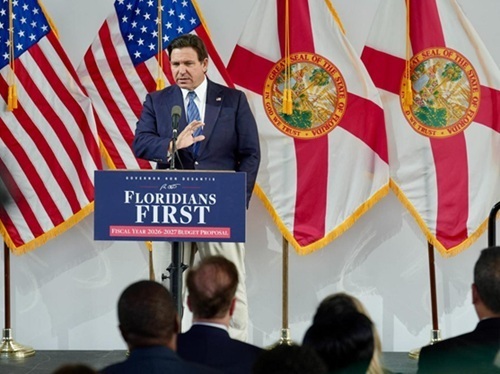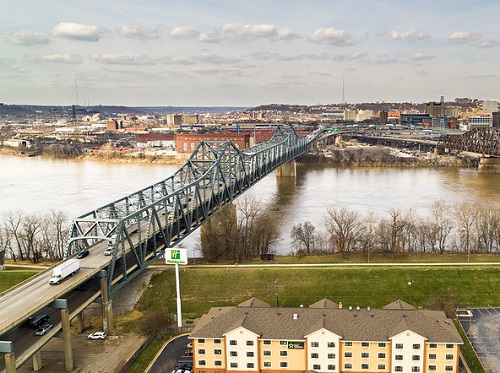A new “street grid” reconnecting downtown Cincinnati to Queensgate is one of several major “innovations” touted by Ohio and Kentucky that are being incorporated into the $3.6 billion Brent Spence Bridge Corridor project.
[Above photo by the Ohio DOT]
The project recently gained environmental approval from the Federal Highway Administration; allowing both states to move forward with this joint transportation infrastructure venture.
Stretching from the Western Hills Viaduct in Ohio to Dixie Highway in Kentucky, the Brent Spence Bridge Corridor project will be built without tolls and transform an eight-mile portion of the I-75/I-71 interstate corridor, including construction of a new companion bridge immediately to the west of the existing Brent Spence Bridge.

“These thoughts and ideas will make the Brent Spence Bridge Corridor even better,” said Ohio Governor Mike DeWine (R) in a statement. “These enhancements aren’t just about reducing congestion on an interstate, it’s about improving safety, reconnecting communities, and enhancing the lives of those who live, work, and visit the area.”
[Editor’s note: in a related effort where roadway safety is concerned, the Gov. DeWine recently issued nearly $87 million to 28 roadway safety projects in 22 counties, with the majority of those projects focused on intersection improvements.]
“These innovations are a key part of continuing the transformational changes we’re making to boost Kentucky’s economy and ensure a higher quality of life here and beyond our borders,” added Kentucky Governor Andy Beshear (D). “They are a testament to the collaboration, teamwork, and goals each state shares to build a better corridor while fulfilling our good neighbor pledge.”
The Brent Spence engineering team added four innovative refinements to the corridor project in Ohio based on its analysis and public feedback. Those innovations ultimately entail:
- Freeing up an additional acre for development or green space by moving southbound I-75 to the western edge of the corridor. In addition, this move allows the roadway to be constructed while minimizing disruptions to traffic on existing southbound I-75. The extra acre for development or green space is in addition to the 9.5 acres that were freed up in November 2022, bringing the total to nearly 11 acres.
- Building a “street grid” to reconnect downtown Cincinnati with Queensgate; adding a new intersection at West Ninth and Gest streets; and making improvements to the intersection of West Seventh and Gest streets.
- Extending West Fifth and West Sixth streets across I-75 to Queensgate, enabling the roadway to connect with Gest in the future. This design will improve safety for pedestrians and those using the shared use path by shortening the distance across I-75 and reducing the highway’s speed limit.
- Combining the I-75 southbound ramps to second and third streets, which will reduce both costs and the project footprint.
- Reconfiguring U.S. 50 lanes, which will improve safety and traffic flow for this important east-west connection.
Jack Marchbanks, director of the Ohio Department of Transportation, noted that several of those “innovations” resulted in part from a “walking tour” he took with Cincinnati Mayor Aftab Pureval of neighborhoods around the I-75 corridor in May 2023.
Meanwhile, several significant design improvements are planned in Northern Kentucky as part of the Brent Spence Corridor:
- Lowering the profile of the interstate by as much as 30 feet between Ninth Street and the new companion bridge, addressing a visibility concern raised by Covington residents during the environmental phase of the project.
- That height reduction is achieved by shifting the southbound ramp to the local roadway network a few hundred feet; aligning the exit ramp on the east side of the interstate and closing the local Fifth Street roadway between Crescent Avenue and Philadelphia Street.
- Redistributing Fifth Street traffic to Third Street, allowing for a gateway intersection to be constructed at Crescent and Third.
- Adjusting entrance locations to the interstate system to line up more like they are today near Pike Street, which addresses concerns raised during the environmental phase about increased traffic changing the residential character of Ninth Street.
- Aligning the interstate through a “cut in the hill” just south of Covington to eliminate the need for significant excavation of the rock embankment and construction of a retaining wall; significantly reducing costs and speeding up the construction schedule.
“From our earlier commitments to separate stormwater systems and pilot Kentucky’s first transparent noise screens, these latest innovations are further proof we’re listening to input and refining the project to make it even better,” noted Jim Gray, secretary of the Kentucky Transportation Cabinet.
According to the Ohio DOT, the next step in the “engineering process” for this project is to make corridor and bridge design “refinements” while updating and confirming traffic and environmental studies, as needed.
 States
States
NCDOT Staff Participate in ‘Explosive’ Technical Training
December 19, 2025 States
States

